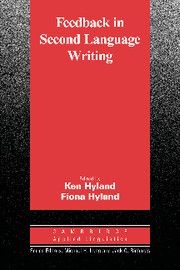Book contents
- Frontmatter
- Contents
- Contributors
- Series editors' preface
- Preface
- Chapter 1 Contexts and issues in feedback on L2 writing: An introduction
- I SITUATING FEEDBACK: SOCIOCULTURAL DIMENSIONS
- II SHAPING FEEDBACK: DELIVERY AND FOCUS DIMENSIONS
- Chapter 5 Does error feedback help student writers? New evidence on the short- and long-term effects of written error correction
- Chapter 6 Electronic feedback and second language writing
- Chapter 7 Resource-rich Web-based feedback: Helping learners become independent writers
- Chapter 8 Feedback in portfolio-based writing courses
- Chapter 9 Students and research: Reflective feedback for I-Search papers
- III NEGOTIATING FEEDBACK: INTERPERSONAL AND INTERACTIONAL DIMENSIONS
- Author index
- Subject index
Chapter 7 - Resource-rich Web-based feedback: Helping learners become independent writers
Published online by Cambridge University Press: 05 October 2012
- Frontmatter
- Contents
- Contributors
- Series editors' preface
- Preface
- Chapter 1 Contexts and issues in feedback on L2 writing: An introduction
- I SITUATING FEEDBACK: SOCIOCULTURAL DIMENSIONS
- II SHAPING FEEDBACK: DELIVERY AND FOCUS DIMENSIONS
- Chapter 5 Does error feedback help student writers? New evidence on the short- and long-term effects of written error correction
- Chapter 6 Electronic feedback and second language writing
- Chapter 7 Resource-rich Web-based feedback: Helping learners become independent writers
- Chapter 8 Feedback in portfolio-based writing courses
- Chapter 9 Students and research: Reflective feedback for I-Search papers
- III NEGOTIATING FEEDBACK: INTERPERSONAL AND INTERACTIONAL DIMENSIONS
- Author index
- Subject index
Summary
This chapter reviews some of the problems in manual and automatic feedback to student writing and describes software tools I have developed to address some of these problems. The purpose of these tools is to encourage learners to look up language patterns and other information in online resources as they write and revise and to help teachers guide their students in using these resources effectively as writing aids.
The wider goal of this approach is to provide novice writers the means to access comprehensive and targeted input and to assist teachers to guide students in exploring appropriate resources and thus to become less dependent on their teachers' support. The tools are designed to improve students' linguistic performance and competence in the EFL context of Hong Kong, but the methodology may be helpful for novice writers in general and for teachers of other languages and subjects when responding to student texts.
Theoretical issues and practical constraints in form-focused feedback
In spite of criticisms of form-focused feedback, (e.g., Krashen, 1982; Truscott, 1996), second language acquisition (SLA) researchers increasingly appear to recognize that language acquisition is optimized when learners attend to both meaning and form (e.g., Doughty & Varela, 1998; Ellis, 2002). However, the drive to provide form-focused feedback is discouraging to many language teachers, especially in foreign language (FL) contexts, who are compelled by educational and social pressures to spend the greater part of their time in what often seems a fruitless attempt to eradicate interlanguage errors at the sentence level (Tsui, 1996).
Information
- Type
- Chapter
- Information
- Feedback in Second Language WritingContexts and Issues, pp. 123 - 139Publisher: Cambridge University PressPrint publication year: 2006
Accessibility standard: Unknown
Why this information is here
This section outlines the accessibility features of this content - including support for screen readers, full keyboard navigation and high-contrast display options. This may not be relevant for you.Accessibility Information
- 15
- Cited by
